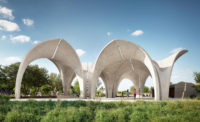At the confluence of the San Pedro Creek and San Antonio River just south of downtown, a sculptural new pavilion is rising from the banks. Commissioned by the nonprofit San Antonio River Foundation (SARF) and slated to open at the end of 2017, the threeacre Confluence Park will serve as an educational outpost for teaching schoolchildren about the watershed, and as a recreational facility for the wider community. The total project budget of $12.8 million, raised primarily through private donors but with some public funding, includes a maintenance and education endowment, which—in response to local educators’ needs—will allow for transportation for students to and from the park.
Local architectural firm Lake|Flato was selected for the project in 2014 and engaged Andrew Kudless of San Francisco–based office Matsys—known for its work in material research and computational design—to consult on the pavilion. “Andrew’s work is formally much different from that of our firm, but it’s not form for the sake of form,” says Lake|Flato associate partner Tenna Florian. Kudless developed a scheme for a 30-foot-high canopy of enormous cast-on-site concrete panels that will capture and funnel rainwater into a 100,000-gallon underground storage tank, to be used later for irrigation and toilets. The park will also include a classroom building, native-plant gardens designed by Rialto Studio, and a bike-share station.
The site—a city-owned empty lot, previously used as a staging area for utility trucks—backs up to a residential street in an underserved part of San Antonio. During initial public meetings, neighbors were skeptical, citing safety concerns and asking for a fence between the end of the street and the park. But since construction began, feelings seem to have changed: “They’re now overwhelmingly enthusiastic,” says Florian, “and have asked for gates in the fence, to have easy access to this new neighborhood amenity.”
Read more about the concrete pavilion, and hear from Andrew Kudless, in the March/April issue of SNAP.
Back to Design for the Public Realm







Post a comment to this article
Report Abusive Comment